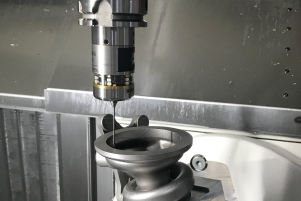


by Hannah Brown on Aug 15, 2018 3:01:00 PM

For over fifteen years, software company, MSP has been revolutionising the way aluminium, titanium and composite parts are made and measured with their products NC-Checker and NC-PartLocator. More recently, the company have worked to improve processes for new technologies such as additive manufacturing (also known as 3D printing).
Their work has been featured within an article written by Renishaw’s Director of Global Solutions Centres, Marc Saunders. He goes into detail about the challenges within the AM machining process, using a case study to demonstrate how best to solve them.
Within many industries, the use of additive manufacturing (AM) has increased significantly over the last few years. It is a flexible manufacturing method, enabling the design and manufacture of complex parts which would not be possible otherwise. It is capable of producing strong yet lightweight structures with internal features or complex geometries. Furthermore, this technique can speed up processes as complex parts can be made as a single piece and no longer need to be machined separately. AM produces very little waste and is much more efficient than traditional manufacturing methods.
Despite these benefits, additive manufacturing is not a stable process and the parts it produces are not 100% accurate. Distortion can occur within the build process and finish machining is often needed to bring the part into tolerance and ensure surfaces are smooth and flat as desired. This is difficult however, as a precise alignment is needed to cut the part accurately, something which is hard to achieve when it is unknown how the part has changed in the build process. In addition to this, fixturing difficulty, very little stock material and inconsistent condition of supply can also cause major frustrations.

MSP has now helped multiple AM companies with their finish machining challenges.
MSP solve these issues to create high accuracy and consistent parts within AM. NC-Checker ensures the machine tool’s geometric performance is accurate enough for the part to be machined correctly. It produces a ‘Benchmark’ report which shows any errors affecting how accurately the AM part will be cut. This is very important when there is little stock material. NC-PartLocator automates part setup for the AM finish machining process by calculating precise alignments for each separate machining operation. It probes the AM part to find out where the part and each feature really are. This data is then used to create new alignments, accommodating for any errors due to part distortion. Precise fixturing is not required and novel fixturing can be implemented. Using these products within the AM machining process eliminates machine geometry and part setup errors, ensuring finished parts are within tolerance and have good surface finish.
Marc’s full article on challenges in additive machining can be found here.
To understand in detail how NC-Checker and NC-PartLocator can help the finishing of your additive parts, contact the team here.


